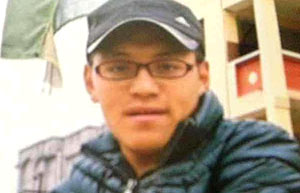- A Tibetan father of three set himself on fire and died in eastern Tibet yesterday (February 13), the third day of Tibetan New Year (Losar), according to Tibetan exile sources.
- His self-immolation came on the same day as a Tibetan in his twenties set fire to himself by the Boudha stupa in Kathmandu, Nepal. The Tibetan, who has been identified by Tibetan exile sources as a monk and the son of a reincarnate lama, died in hospital last night (February 13). He had arrived recently in Nepal from Tibet.
- The two self-immolations follow the death of a Tibetan monk in his thirties called Lobsang Namgyal who set fire to himself and died on February 3. Lobsang Namgyal, who was known as a serious and exceptional scholar, was the 100th known Tibetan to self-immolate inside the PRC.
Self-immolation in Amdo of Tibetan father of three

25-year old monk called Drongchen Tsering (or Drongtse) who recently arrived in Nepal from Tibet self-immolated in Kathmandu on February 13.
Tibetan New Year (Losar) is traditionally marked by celebrations with family and friends, but for the past four years since the crackdown intensified in Tibetan areas Tibetans have chosen not to celebrate but to mark the festival with prayer.
The self-immolations of Drugpa Khar and Lobsang Namgyal (on February 3) occurred following the imposition of harsher and more systematic measures that have been imposed by the Chinese authorities to deter protests, including charges of ‘intentional homicide’ against Tibetans accused of “inciting” self-immolations. (ICT report, Six Tibetans in Gansu sentenced after protecting body of self-immolator in aggressive drive to criminalize self-immolations).
Drugpa Khar was a father of three children aged between one year old and six. He was born in Lushu Kyi village in Tsoe, Kanlho, theTibetan area of Amdo.
Lobsang Namgyal, who died on February 3, was described by Kirti monks in exile in contact with Tibetans who knew him as an “exemplary” monk. The Kirti monks in Dharamsala who are monitoring the case reported: “Lobsang Namgyal suddenly disappeared for about two weeks in September 2012. His classmates and relatives searched for him, but were unable to find him, and later came to know that he had been detained by Ngaba county police. Under various forms of intimidation, they got him to renounce monkhood so that he could no longer stay in the monastery, and the police put it about that they had arrested him in a brothel. For several months afterwards, he sought refuge with relatives in a remote pastoral area, but he was traced there by police, who continued to harass him. Before committing his protest, he had returned to the monastery, saying that from now on he would go elsewhere to practise purification.”
Tibetan who self-immolated in Kathmandu dies
The young Tibetan man who set himself on fire yesterday (February 13) at one of the most important Buddhist pilgrimage sites in Nepal has died, according to reports from Nepal. The young man was identified by exile Tibetan sources as a 25-year old monk called Drongchen Tsering (or Drongtse) who recently arrived in Nepal from Tibet. The same sources said that he was the son of a reincarnate lama and was from Kardze (Chinese: Ganze) Tibetan Autonomous Prefecture in Sichuan Province, the Tibetan area of Kham.
The Tibetan man wrapped his body in cotton held together with wire and doused his body in petrol before setting himself on fire at the Boudha stupa in Kathmandu.
Security has been stepped up in the Boudhanath area of Nepal following the self-immolation yesterday. A Tibetan present at the stupa after the self-immolation said that many Tibetans appeared too nervous to speak about the incident; Tibetans in Nepal are increasingly vulnerable and at risk due to the Chinese authorities more entrenched and systematic approach to constraining the Tibetan community in Nepal. (ICT report, Dangerous Crossing – 2011 Update).

